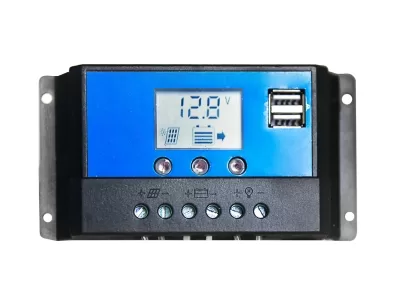Solar energy has gained popularity as a clean, renewable, and sustainable power source. To harness this energy efficiently, solar charge controllers play a crucial role in solar panel systems. They regulate the voltage and current coming from the solar panels to the battery, ensuring that the battery is charged correctly and preventing it from overcharging. In this article, we will explore the types of solar charge controllers, their working mechanism, benefits, and how to choose the right one for your solar panel system.

Types of Solar Charge Controllers
There are two main types of solar charge controllers: Pulse Width Modulation (PWM) and Maximum Power Point Tracking (MPPT). Each has its advantages and disadvantages, so it’s essential to understand how they work to select the best one for your needs.
PWM (Pulse Width Modulation)
PWM charge controllers are an older and more affordable technology. They work by connecting the solar panels directly to the battery, regulating the voltage to match the battery’s requirements. While PWM controllers are reliable and efficient for smaller solar systems, they can be less efficient for larger systems, as they do not optimize the conversion of solar energy into electrical energy.
MPPT (Maximum Power Point Tracking)
MPPT charge controllers are more advanced and expensive than PWM controllers. They are designed to track the maximum power point of the solar panels, allowing them to operate at peak efficiency. MPPT controllers can convert excess voltage into amperage, resulting in up to 30% more efficiency in energy conversion compared to PWM controllers. They are ideal for larger solar panel systems.
How Solar Charge Controllers Work
Solar charge controllers regulate the flow of electrical energy between the solar panels and the battery to ensure optimal battery charging.
Voltage Regulation
Voltage regulation prevents overcharging by limiting the voltage that reaches the battery. When the battery is fully charged, the controller disconnects the solar panels, preventing further charging.
Current Regulation
Current regulation prevents the battery from discharging back into the solar panels during nighttime or low light conditions. The controller acts as a one-way valve, allowing the current to flow only from the panels to the battery.
Benefits of Using Solar Charge Controllers
Using solar charge controllers in your solar panel system has several benefits:
- They protect your battery from overcharging, which prolongs battery life.
- They prevent reverse current flow, ensuring that your battery does not discharge back into the solar panels.
- They improve the overall efficiency of your solar panel system by regulating voltage and current.
Selecting the Right Solar Charge Controller for Your System
To choose the right solar charge controller, you need to understand your solar panel system’s requirements and match the controller accordingly.
Understanding Your Solar Panel System Requirements
Consider the following factors when assessing your solar panel system requirements:
- The total wattage of your solar panels: This determines the amount of energy your system generates.
- The voltage of your battery bank: Ensure the charge controller is compatible with your battery bank’s voltage.
- The maximum amperage your system will produce: This helps in selecting a charge controller with the appropriate current rating.
Matching the Charge Controller to Your System
Once you understand your system’s requirements, you can select the right charge controller by considering:
- Type of controller: Choose between PWM or MPPT based on your system’s size and efficiency requirements.
- Current rating: Ensure the charge controller’s current rating matches or exceeds the maximum amperage your system will produce.
- Compatibility: Confirm that the controller is compatible with your battery bank’s voltage and other system components.
Installation Tips and Best Practices
Proper installation of your solar charge controller is crucial for optimal system performance. Here are some tips and best practices:
- Place the charge controller close to the battery bank to minimize voltage drop and energy loss.
- Ensure proper ventilation around the charge controller to avoid overheating.
- Follow the manufacturer’s guidelines for connecting the solar panels, battery, and other components to the controller.
- Use appropriately sized wires and connectors to ensure efficient energy transfer and minimize energy loss.
Maintenance and Troubleshooting
Regular maintenance and troubleshooting can help prolong the life of your solar charge controller and ensure optimal system performance. Some maintenance tips include:
- Periodically clean the charge controller and surrounding area to prevent dust and debris buildup.
- Inspect the connections and wiring for signs of corrosion or damage.
- Monitor the performance of your solar panel system to identify any issues or inefficiencies.
Conclusion
Solar charge controllers are essential components in a solar panel system, providing efficient energy conversion and protecting your battery from overcharging. Understanding the types of controllers, how they work, and selecting the right one for your system is crucial for harnessing solar energy effectively. Proper installation, maintenance, and troubleshooting can help ensure your system operates efficiently and prolongs the life of your charge controller.
Frequently Asked Questions
How do I choose between a PWM and MPPT solar charge controller?
Consider your solar panel system’s size and efficiency requirements. PWM controllers are suitable for smaller systems, while MPPT controllers are ideal for larger systems that require higher efficiency.
Can I use a solar charge controller with any type of battery?
Most solar charge controllers are compatible with various battery types, including lead-acid, lithium, and gel batteries. Always check the manufacturer’s guidelines for compatibility.
What is the ideal location for installing a solar charge controller?
Install the charge controller close to the battery bank, ensuring proper ventilation and easy access for maintenance.
Do I need a solar charge controller for a small solar panel system?
While it may be possible to operate a small solar panel system without a charge controller, it’s recommended to use one to protect your battery from overcharging and improve overall system efficiency.
How often should I perform maintenance on my solar charge controller?
Regular maintenance, such as cleaning and inspecting connections, should be performed every 3 to 6 months or as per the manufacturer’s guidelines.